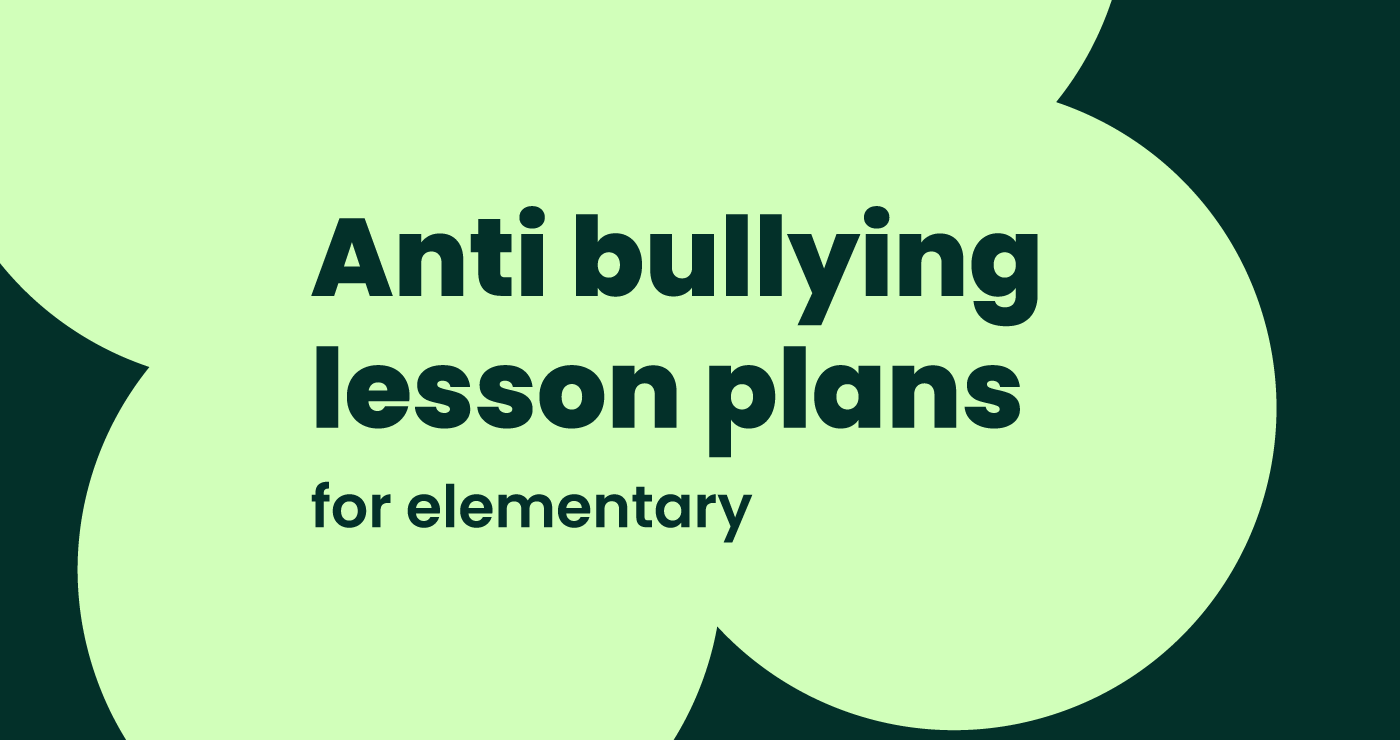According to the National Center for Educational Statistics (NCES), one out of every five students reports being the victim of bullying behavior.
Deep into the digital age, perpetrators now have a powerful platform from which to bully their victims, with the added “advantage” of anonymity. According to a 2020 study, over 20% of 9 to 12-year-olds have been cyberbullied, partaken in cyberbullying themselves, or have witnessed the behavior online/ on social media.
It’s imperative that schools take a considered and committed approach to educating children on all aspects of bullying, and this should begin at elementary school age to best combat the issue and stop bullying. This is one crucial step toward creating a positive school culture. If you’d like to know more about this, have a read of our Creating a Positive School Culture blog.
What is bullying?
The American Psychological Association (APA) defines bullying as “a form of aggressive behavior in which someone intentionally and repeatedly causes another person injury or discomfort. Bullying can take the form of physical contact, words, or more subtle actions.”
Generally speaking, bullies target vulnerable children with noticeable differences, such as in appearance and preferences; for example, disabilities and gender dysphoria are common targets for cruel treatment.
The scope of bullying has also widened in recent years, with differences as minute as food allergies attracting negative attention. Unfortunately, around a third of children with allergies report being bullied because of it.
As Jess Grelle, SVP of Innovation at allergy-friendly company Safe + Fair says, “Not only are allergies surprisingly common, but they can be life-threatening and certainly no joke. Our mission to normalize allergy-friendly eating through trustworthy, transparent products will hopefully help to prevent such instances of mindless bullying of children suffering from allergies.”
Teaching elementary children about bullying
The primary aim of educating elementary children about bullying is to teach students:
- to understand what bullying is (and what it isn’t)
- to be able to identify different types of bullying
- to recognize the importance of reaching out and how to
- to consider how best to support someone they see being bullied while staying safe
Here are some key components for effective elementary anti-bullying education lessons:
Understanding bullying
Get pupils to discuss (in pairs or small groups) the question, “What is bullying?” You can also provide other bullying-related discussion questions and ask your grade level or middle school students to think of bullying situations.
It’s also important to discuss and help the students to understand what bullying is not. For example, accidentally bumping into someone and then apologizing to them is not an act of bullying, while intentionally knocking someone to intimidate them or cause them harm or embarrassment IS a form of bullying.
Be sure to include examples of cyberbullying. The Oxford Dictionary defines cyberbullying as “the use of electronic communication to bully a person, typically by sending messages of an intimidating or threatening nature.”
Who is vulnerable to being bullied?
Discuss which children are typically the most vulnerable to being bullied. Ask the children to discuss this in pairs or groups and then share it with the class and discuss.
- Discuss differences and explore reasons to see them as valuable and positive
- Discuss disabilities and differences such as autism and what they mean, including those that aren’t visibly obvious, such as epilepsy or serious allergies
What does it look and feel like to be bullied?
Explore with the children aspects of what it looks like and feels like to be bullied, and fill in the gaps, to include the following points:
- Being called mean names or sent mean messages
- Having mean rumors started about you
- Being left out of groups
- Being hit, kicked, or punched
- Having your belongings damaged or destroyed
- Having other children make fun of the way you talk, act, or look
- Feeling afraid to go to school
- Being laughed at when you are hurt or embarrassed
- Being made fun of for being better or worse at something than other children
- Being made to do something you don’t want to do because of unkind peer pressure
Explore the emotions that this would cause, such as embarrassment, anxiety, fear, shame, loneliness, etc.
What does it look and feel like to be a bully?
It’s also extremely important to explore what it means to be a bully. Teachers should let the children know that they are welcome and safe to talk one-on-one about this in confidence.
Bullying traits include:
- Name-calling
- Starting rumors about others
- Trying to embarrass other children
- Purposely leaving kids out of groups or games
- Stealing and/or damaging other children’s things
- Wanting to make another child feel upset or scared
- Pushing or hitting another child
- Saying mean things about another child to make them look bad
- Getting other kids to be mean to others with you
- Wanting other kids to feel afraid of you
- Making fun of how another child talks, acts, or looks
- Thinking it’s cool to laugh at others
- Enjoying other people laughing with you at others
- Sending mean messages online or via text
Reaching out
A key aspect of anti-bullying education is teaching children about what to do in the event that they are bullied or are a bystander or witness someone else being victimized by a bully or bullies.
It’s also important to point out that another excellent reason for reaching out is in the event that a child is involved in bullying behavior and wants to stop.
Discuss effective conflict resolution and the following considerations regarding reaching out:
- Friends – perhaps they think a friend is being bullied, but they are not sure. Explore why reaching out and asking the friend if everything is ok might make an important difference
- Teachers and other school staff – discuss why it might help to tell a teacher or other school staff member like a school counselor about someone being bullied, and use this as an opportunity to clearly outline the school’s specific approach to reporting bullying (as well as making it fundamentally clear that any form of speaking out is encouraged)
- Parents and caregivers – discuss how it might make a difference to talk to a parent or other caregiver about bullying in school or online. Talk about the importance of telling someone and not staying silent.
In some instances, a child may be too embarrassed or afraid to admit that they are being bullied. Discuss the impact of staying silent on the failure to combat the issue at large.
Cross-curricular bullying lesson ideas
A great way to incorporate education around bullying into everyday conversations is to develop classroom activities and cross-curricular lesson plans; this is particularly impactful when built around National bullying prevention month. Ideas include:
English
Assign the children a creative writing task in the language arts, centered around a short story or play about bullying, friendship, inclusion, etc. Give them points that must be included, such as a bullying incident, an act of reaching out, etc.
Another great idea is to write poetry on the topic of bullying.
Science
The impact of kindness and thoughtfulness can be explored in an expansive way by considering how humans’ actions affect animals, nature, the environment, and the planet at large, drawing similarities with the negative ripple effect that can occur as a result of bullying.
If the students have access to computers or iPads, you could set them the task of researching animals that live in groups, working together to survive. For example, some animals huddle together to stay warm, and many work together to hunt for food and transport it back to their family. The children could create presentations on their findings, and discuss how these patterns relate to the need for humans to support one another.
Physical education
Phys. Ed. offers up plenty of opportunities for easily incorporating themes of inclusion, respect, and fairness. Try literally ‘changing the goalposts’ – change rules, have more players on one team than another, play around with how team members are chosen, etc., all with an emphasis on how unfairness can impact individuals, teams, outcomes, morale, and more.
Art
With art, the options are virtually endless. Assign students the task of painting or drawing their own abstract interpretation of how it would feel to be bullied, the relief of reaching out, the shame of being a bully, the relief and pride of changing that behavior, etc.
History
There are countless stories from history that can effectively demonstrate the damage that unkind actions cause.
Martin Luther King’s life and civil rights protests offer up plenty of discussion points. Discuss how and why he specifically promoted the dedication to non-violent resistance and why it was so important that he demonstrated kindness and respect to all, regardless of their behavior towards him.
Design technology
Engage the students in designing areas and concepts that prioritize inclusion, safety, accountability, etc. School facilities, quiet areas, lunch halls, yards, or other open spaces.
Final thoughts
Early education is surely one of the keys to combating bullying most effectively. By engaging elementary school-age children with key concepts and strategies, a solid foundation of understanding can be created that can continue through their schooling years into high school and their professional development.
There are many ways in which teachers and schools can incorporate anti-bullying messages and education into lessons and school ethos, using fun methods that can further drive the messages home in a memorable way. Why not create a handout, worksheet, bulletin board, or toolkit on teaching tolerance and kindness?
If you are an elementary teacher who feels that your school could be doing more to educate on bullying issues, discuss your vision with other teachers and take ideas to the Principal for consideration. And in the meantime, foster an ethos of kindness, self-esteem, respect, and safety in your classroom.
Blogs you may also like

Virtual Campus School: Turning Learning Barriers into Breakthroughs with Kami

How Jeff Kilner and His District Transformed Teaching with Kami



